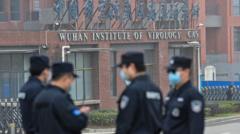The shortage of medical oxygen is particularly dire in low- and middle-income countries, where fewer than 1 in 3 people needing it receive adequate supply, jeopardizing millions of lives.
Invisible Medical Crisis: The Global Shortage of Medical Oxygen

Invisible Medical Crisis: The Global Shortage of Medical Oxygen
A recent report highlights a severe global shortage of medical oxygen, putting millions of lives at risk worldwide.
More than 370 million individuals across the globe require medical oxygen annually as part of their healthcare, yet under a third of those in need receive it, according to a new report published on February 17, 2025, in The Lancet Global Health. The lack of this essential resource became starkly evident during the COVID-19 pandemic, where countless individuals in impoverished nations struggled to breathe even within hospital settings.
A panel of experts, led by pediatrician Dr. Hamish Graham, emphasized the urgent need to address this insufficiency, pointing out that upcoming epidemics and potential pandemics, similar to COVID-19, are expected within the next couple of decades. Dr. Graham stated, “The need is very urgent,” underlining the humanitarian and medical implications of this crisis.
The report proposes that enhancing access to medical oxygen would require an estimated investment of approximately $6.8 billion. However, factors such as recent foreign aid program freezes by the Trump administration threaten to impede progress in this critical area. Carina King, an infectious disease epidemiologist at the Karolinska Institute and a co-author of the report, stressed the necessity for governments and funding bodies to prioritize medical oxygen in their healthcare agendas.
Medical oxygen is essential for numerous conditions affecting people of all ages, including pneumonia, severe infections like malaria and sepsis, surgical procedures, and chronic lung diseases. The ongoing shortfall of this basic medical requirement poses an immense risk, necessitating immediate attention and action from international health authorities and governments alike.
A panel of experts, led by pediatrician Dr. Hamish Graham, emphasized the urgent need to address this insufficiency, pointing out that upcoming epidemics and potential pandemics, similar to COVID-19, are expected within the next couple of decades. Dr. Graham stated, “The need is very urgent,” underlining the humanitarian and medical implications of this crisis.
The report proposes that enhancing access to medical oxygen would require an estimated investment of approximately $6.8 billion. However, factors such as recent foreign aid program freezes by the Trump administration threaten to impede progress in this critical area. Carina King, an infectious disease epidemiologist at the Karolinska Institute and a co-author of the report, stressed the necessity for governments and funding bodies to prioritize medical oxygen in their healthcare agendas.
Medical oxygen is essential for numerous conditions affecting people of all ages, including pneumonia, severe infections like malaria and sepsis, surgical procedures, and chronic lung diseases. The ongoing shortfall of this basic medical requirement poses an immense risk, necessitating immediate attention and action from international health authorities and governments alike.






















